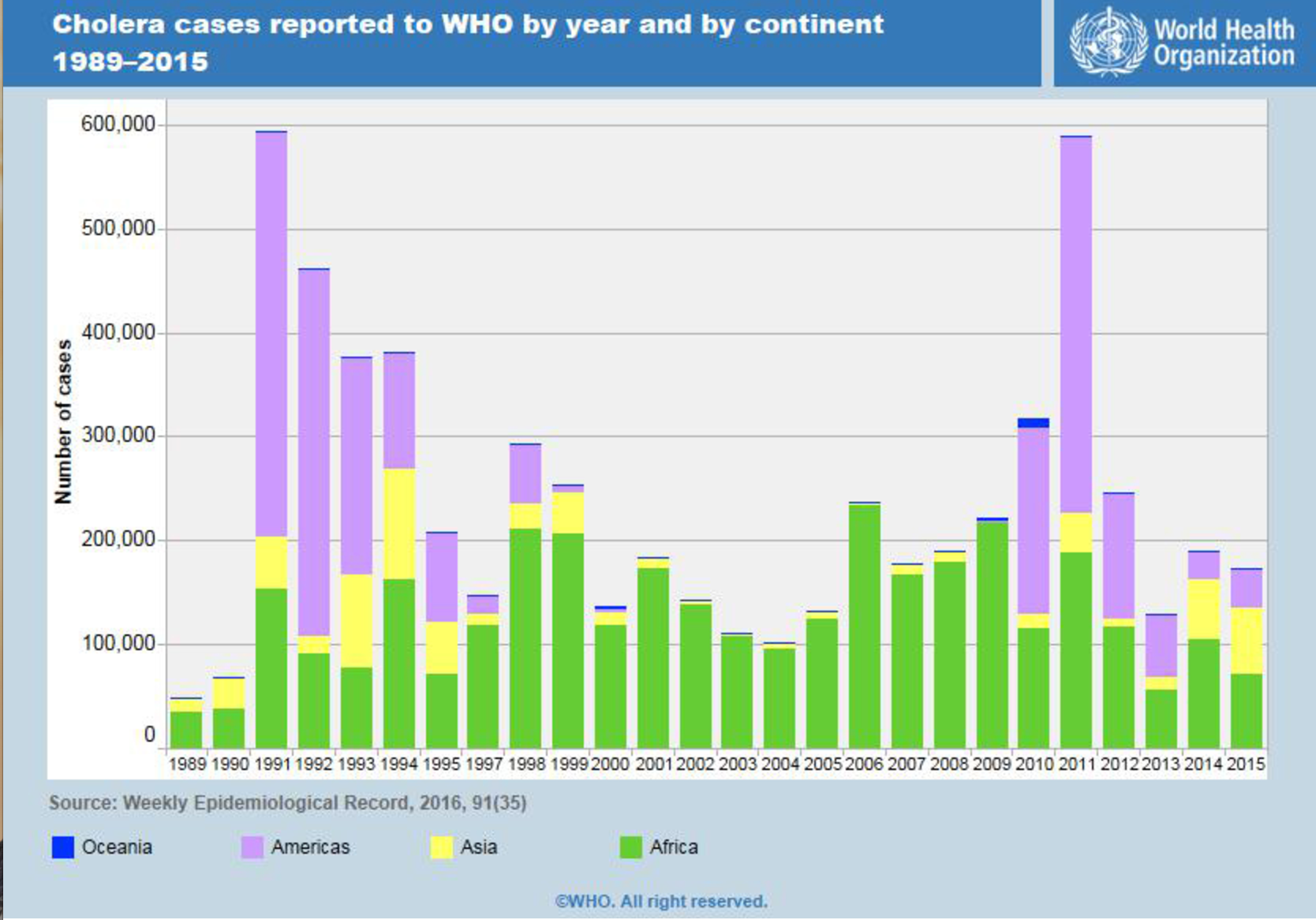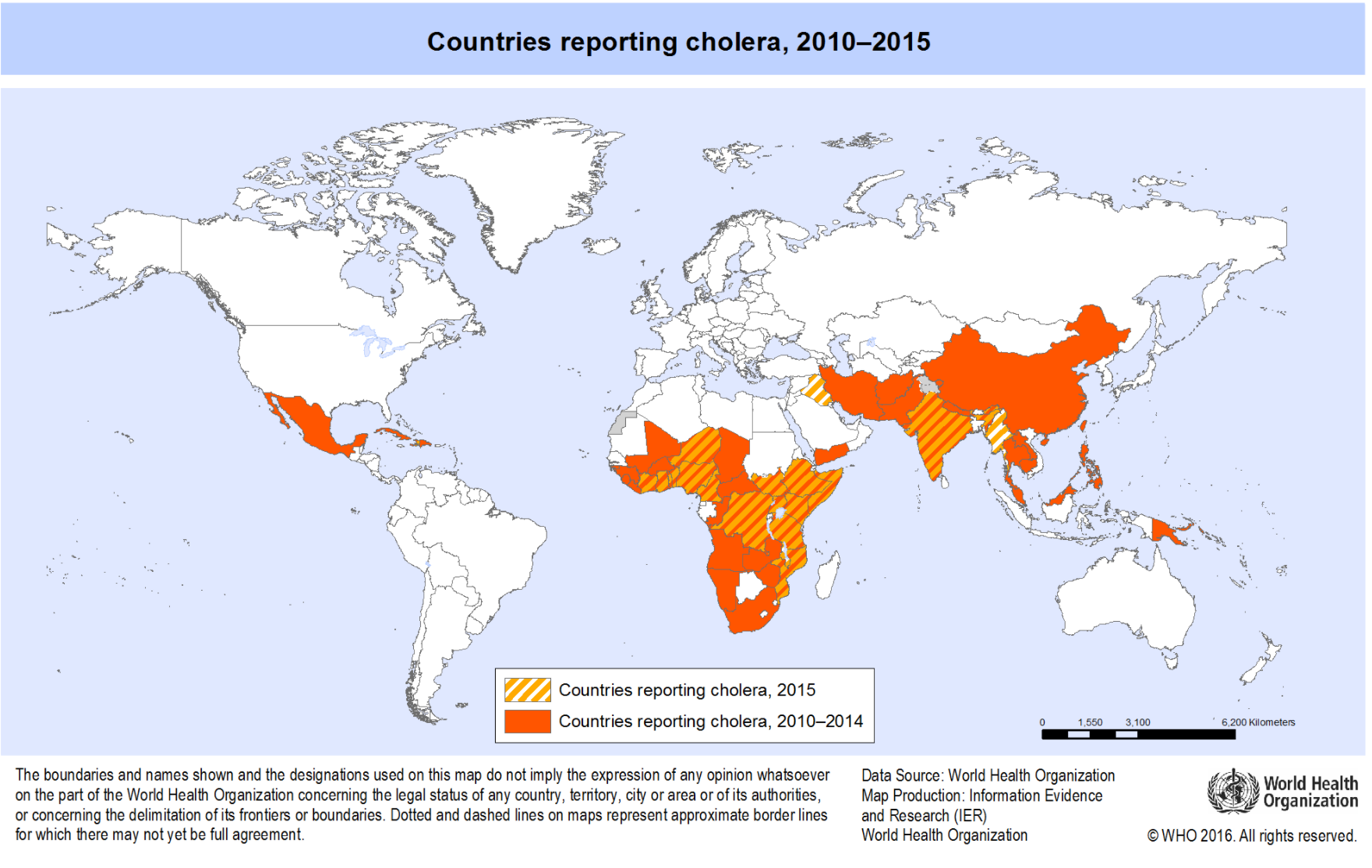Cholera epidemiology and demographics: Difference between revisions
Ahmed Younes (talk | contribs) |
Ahmed Younes (talk | contribs) No edit summary |
||
| Line 9: | Line 9: | ||
==2017 Yemen outbreak== | ==2017 Yemen outbreak== | ||
{| style="border: 0px; margin: 5px;" width="1000px" | |||
| align="center" style="background:#4479BA; padding: 10px 10px;" |{{fontcolor|#FFF|'''Date'''}} | |||
| align="center" style="background:#4479BA; padding: 5px 5px;" |{{fontcolor|#FFF|'''Cases''' (confirmed and suspected)}} | |||
| align="center" style="background:#4479BA; padding: 5px 5px;" |{{fontcolor|#FFF|'''Deaths'''}} | |||
| align="center" style="background:#4479BA; padding: 5px 5px;" |{{fontcolor|#FFF|'''More details'''}} | |||
Deaths | |||
|- | |- | ||
|June 11th, 2017 | | style="padding: 5px 5px; background: #EBEBEB;" |June 11th, 2017|| style="padding: 5px 5px; background: #F2F2F2;" |101,820|| style="padding: 5px 5px; background: #F2F2F2;" |791 (0.7%) | ||
|101,820 | | style="padding: 5px 5px; background: #F2F2F2;" | | ||
|791 | *Since the [[outbreak]] started in April 27, 2017, a total of 101,820 cases were suspected from which 791 died.<ref name="urlWHO | Number of suspected cholera cases reaches 100 000 in Yemen">{{cite web |url=http://www.who.int/mediacentre/news/releases/2017/suspected-cholera-yemen/en/ |title=WHO | Number of suspected cholera cases reaches 100 000 in Yemen |format= |work= |accessdate=}}</ref> | ||
| | |||
*Since the outbreak started in April 27, 2017, a total of 101,820 cases were suspected from which 791 died.<ref name="urlWHO | Number of suspected cholera cases reaches 100 000 in Yemen">{{cite web |url=http://www.who.int/mediacentre/news/releases/2017/suspected-cholera-yemen/en/ |title=WHO | Number of suspected cholera cases reaches 100 000 in Yemen |format= |work= |accessdate=}}</ref> | |||
*Most of the fatalities are children below 15 years (46% of cases) and elderly over 60 years (33% of cases). | *Most of the fatalities are children below 15 years (46% of cases) and elderly over 60 years (33% of cases). | ||
*The disease is spreading in 19 out of 23 governorates in the country that is war torn.<ref name="urlYemen cholera cases pass the 100,000 mark: WHO | Reuters">{{cite web |url=http://in.reuters.com/article/us-yemen-cholera-idINKBN18Z17N?feedType=RSS&feedName=health&utm_source=Twitter&utm_medium=Social&utm_campaign=Feed%3A+reuters%2FINhealth+%28News+%2F+IN+%2F+Health%29 |title=Yemen cholera cases pass the 100,000 mark: WHO | Reuters |format= |work= |accessdate=}}</ref> | *The disease is spreading in 19 out of 23 governorates in the country that is war torn.<ref name="urlYemen cholera cases pass the 100,000 mark: WHO | Reuters">{{cite web |url=http://in.reuters.com/article/us-yemen-cholera-idINKBN18Z17N?feedType=RSS&feedName=health&utm_source=Twitter&utm_medium=Social&utm_campaign=Feed%3A+reuters%2FINhealth+%28News+%2F+IN+%2F+Health%29 |title=Yemen cholera cases pass the 100,000 mark: WHO | Reuters |format= |work= |accessdate=}}</ref> | ||
*The health system in the country is nearly destroyed which makes the mission to control the disease even harder. After 2 years of conflict, less than half of the healthcare centers are working. Medical supplies are entering Yemen in a rate that is third of what it used to be before the conflict. Moreover, infrastructure is terribly damaged preventing 14.5 million people from having access to clean water and sanitation. | *The health system in the country is nearly destroyed which makes the mission to control the disease even harder. After 2 years of conflict, less than half of the healthcare centers are working. Medical supplies are entering Yemen in a rate that is third of what it used to be before the conflict. Moreover, infrastructure is terribly damaged preventing 14.5 million people from having access to clean water and sanitation. | ||
*Efforts by WHO and UNICEF are made to control the outbreak especially in the “hotspots” or the most affected areas. | *Efforts by [[WHO]] and UNICEF are made to control the outbreak especially in the “hotspots” or the most affected areas. | ||
*66.7 million US dollars are invested in the fight against the outbreak. Till the moment, 3.5 million people have been reached through disinfecting water tanks, chlorination of water and distributing hygiene kits.<ref name="urlWHO | Number of suspected cholera cases reaches 100 000 in Yemen" | *66.7 million US dollars are invested in the fight against the outbreak. Till the moment, 3.5 million people have been reached through disinfecting water tanks, chlorination of water and distributing hygiene kits.<ref name="urlWHO | Number of suspected cholera cases reaches 100 000 in Yemen" /> | ||
|- | |- | ||
|June 25th, 2017 | | style="padding: 5px 5px; background: #EBEBEB;" |June 25th, 2017 | ||
|200,000 | | style="padding: 5px 5px; background: #F2F2F2;" |200,000 | ||
|1300 | | style="padding: 5px 5px; background: #F2F2F2;" |1300 (0.65%) | ||
| | | style="padding: 5px 5px; background: #F2F2F2;" | | ||
* Number of suspected cases has doubled so as the number of dead, making it the worst cholera outbreak in the recent history. | * Number of suspected cases has doubled so as the number of dead, making it the worst cholera outbreak in the recent history. | ||
* Numbers are expected to rise in the next few weeks. | * Numbers are expected to rise in the next few weeks. | ||
* WHO and UNICEF are scaling up their efforts to contain the outbreak. | * WHO and UNICEF are scaling up their efforts to contain the outbreak. | ||
* Rapid response teams are going from house to house educating people about the effective measures for primary and secondary prevention. | * Rapid response teams are going from house to house educating people about the effective measures for [[Primary prevention|primary]] and [[secondary prevention]]. | ||
* Local health workers (estimated 30,000 of them) have not been paid for 10 months due to the ongoing conflict and economic crisis, making the efforts to contain the infection more difficult. | * Local health workers (estimated 30,000 of them) have not been paid for 10 months due to the ongoing conflict and economic crisis, making the efforts to contain the infection more difficult. | ||
|} | |} | ||
Revision as of 16:30, 25 June 2017
|
Cholera Microchapters |
|
Diagnosis |
|---|
|
Treatment |
|
Case Studies |
|
Cholera epidemiology and demographics On the Web |
|
American Roentgen Ray Society Images of Cholera epidemiology and demographics |
|
Risk calculators and risk factors for Cholera epidemiology and demographics |
Editor-In-Chief: C. Michael Gibson, M.S., M.D. [1]; Associate Editors-In-Chief: Sara Mehrsefat, M.D. [2], Tarek Nafee, M.D. [3], Priyamvada Singh, MBBS [4]
Overview
In 2015, 172,454 cases and 1,304 deaths of cholera were reported to WHO worldwide. Outbreaks continued to affect several countries. Overall, 41% of cases were reported from Africa, 37% from Asia, and 21% from the Americas.[1] In the early 1980s, mortality rates are believed to exceeded 3 million deaths a year. It is difficult to calculate exact numbers of cases, as many go unreported due to concerns that an outbreak may have a negative impact on the tourism of a country.[2] Cholera remains both epidemic and endemic in many areas of the world. Although much is known about the mechanisms behind the spread of cholera, this has not led to a full understanding of what makes cholera outbreaks happen some places but not others. Lack of adequate treatment of human feces and/or drinking water greatly facilitates the spread of cholera. Bodies of water can serve as a reservoir of the disease. Seafood shipped over long distances can also spread the disease. Cases of cholera were not observed in the Americas for most of the 20th century, thought the disease reappeared towards the end of that century and seems likely to persist.[3]
2017 Yemen outbreak
| Date | Cases (confirmed and suspected) | Deaths | More details |
| June 11th, 2017 | 101,820 | 791 (0.7%) |
|
| June 25th, 2017 | 200,000 | 1300 (0.65%) |
|
Epidemiology and Demographics
Incidence
- In 2015, 172,454 cases and 1,304 deaths of cholera were reported to WHO worldwide. Outbreaks continued to affect several countries.
- Overall, 41% of cases were reported from Africa, 37% from Asia, and 21% from the Americas.[1]
- Worldwide, cholera affects an estimated 1.4 to 4.3 million people and causes 28,000 to 142,000 deaths a year as of 2012.[6][7]
Origin and Spread
Cholera was originally endemic to the Indian subcontinent, with the Ganges River likely serving as a contamination reservoir. It spread by trade routes (both land- and sea-based) to Russia, then to Western Europe, and from Europe to North America. Cholera is no longer considered an issue in Europe and North America, due to filtering and chlorination of the water supply.
Gender
Cholera occurs equally in males and females.
Age
- In non-endemic areas, cholera occurs equally in all age groups.
- In endemic regions, children older than the age of 2 years are most commonly infected which cholera. Illness is uncommon before children reach 2 years of age, likely due to passive immunity.
Geographic Distribution
Cholera in the United States
In the United States, the occurrence of cholera is very low (0-5 cases per year) and is usually due to ingestion of contaminated food or infection during international travel. There has been a modest increase in imported cases since 1991 related to travel and ongoing epidemics.[8]
Cholera in the Developing World
The highest incidencce of cholera in the developing world occurs in the following regions:[9][10]
- Africa: Mozambique, Liberia, Democratic Republic of Congo, Niger
- Asia: Indonesia, Bangladesh, India
- The Americas: Dominican Republic, Haiti
- The Middle East: Yemen


Case Fatality Rates
- In 2015, the case fatality rates (CFRs) for cholera ranged from 0.0% to 11.7%; globally, the overall CFR was 0.8%.[11]
- CFRs >1% were reported by 15 countries.
- Of these 15 countries, CFR >5% were reported in Myanmar and Niger.
- In Yemen, the case-fatality rate is reported to be between 4% to 5%.
- The average case fatality rate for Europe and the Americas is estimated to be around 1%.
- At the Treatment Center of the International Center for Diarrheal Disease Research in Bangladesh, less than 1% of patients with severe dehydration die.
- In Africa, a marked decline in case fatality rates has reported since 1970.
- in South America, low case fatality rates have been achieved.
References
- ↑ 1.0 1.1 World Health Organization. Global Health Observatory (GHO) data. http://www.who.int/gho/epidemic_diseases/cholera/en/ Accessed on October 5th, 2016
- ↑ Sack DA, Sack RB, Chaignat CL (2006). "Getting serious about cholera". N. Engl. J. Med. 355 (7): 649–51. doi:10.1056/NEJMp068144. PMID 16914700. Unknown parameter
|month=ignored (help) - ↑ Blake, PA (1993). "Epidemiology of cholera in the Americas". Gastroenterology clinics of North America. 22 (3): 639–60. PMID 7691740.
- ↑ 4.0 4.1 "WHO | Number of suspected cholera cases reaches 100 000 in Yemen".
- ↑ "Yemen cholera cases pass the 100,000 mark: WHO | Reuters".
- ↑ World Health Organization. Cholera. (2016) http://www.who.int/mediacentre/factsheets/fs107/en/ Accessed on October 5th,2016
- ↑ Ali M, Lopez AL, You YA, et al. The global burden of cholera. Bulletin World Health Organization 2012; 90: 209–18A.
- ↑ Centers for Disease Control and prevention. Sources of Infection & Risk Factors. http://www.cdc.gov/cholera/infection-sources.html Accessed on October 5th, 2016
- ↑ World Health Organization. Cholera Emergencies preparedness, response. http://www.who.int/csr/don/archive/disease/cholera/en/
- ↑ World Health Organization. Cholera Global Health Observatory Map Gallery http://gamapserver.who.int/mapLibrary/app/searchResults.aspx
- ↑ World Heath Organization. Global Health Observatory (GHO) 2016. dathttp://www.who.int/gho/epidemic_diseases/cholera/case_fatality_rate_text/en